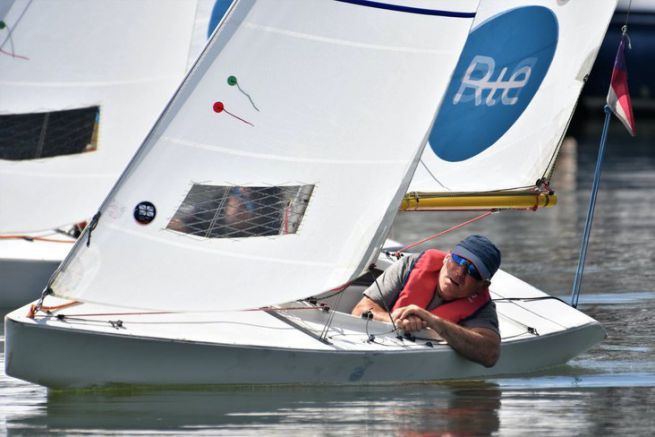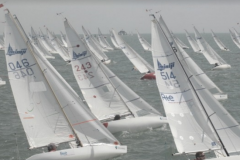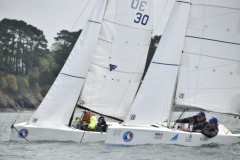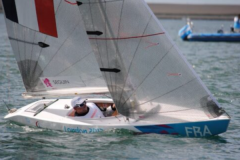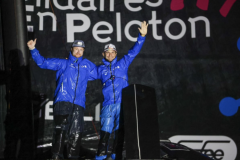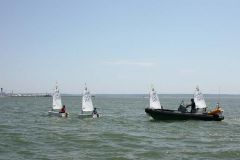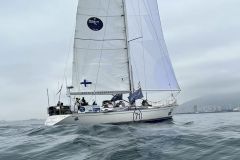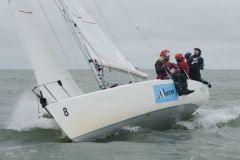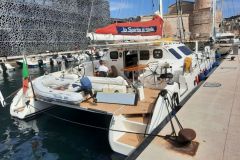Reminder of the history of the Lorient handivan fleet
For its debut, the disabled section was loaned four MinJi. They are used initially in a confidential way, because the section is not yet well known. But in 2019, things accelerated: the section made its MiniJi available to the Cité de la Voile, the discovery centre for ocean racing located in Lorient-La Base. They are used for the initiation to navigation that the City offers to its visitors in summer, and will remain there all year round. The result of this partnership: more global navigation, more communication, and more requests from people with disabilities... To finish today where there are no boats for the section!
With the financial support of RTE, the electricity transmission company, four additional MiniJi are ordered. To continue this development, the section hopes to be able to use a collective boat: a Fillao, which is a small nine metre open schooner. Five or six people, some of whom are disabled, could be boarded. Sellor, the structure that manages a large part of the facilities linked to Lorient-La Base, has two of them... but unfortunately, the pooling of resources is not easy to implement. Ideally, the section should also have a double boat so that the person with a disability and a volunteer can progress together.
As far as equipment is concerned, the section already uses the disability-related infrastructure available in the Cité de la Voile, and is then labelled "tourism and disability" for the four types of disabilities. But there is a stem missing to board and disembark people in wheelchairs, which would allow boaters with disabilities to sail more. It is with Lorient Agglomération that things should find a favourable outcome.
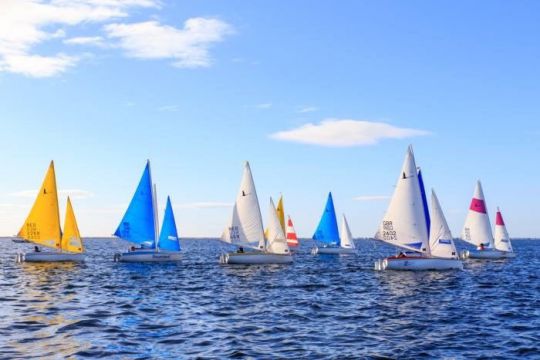
Bateaux.com - How has sailing accessibility developed in France?
Jean-Charles Desvouas - Of course, there are people who have been disabled, who used to sail before and who have continued after. So a certain accessibility has always existed, but this practice has been formalised in the context of the development of handi-sport, and the corresponding federation. Some time ago, however, it was the French Sailing Federation that took over the management of Handi Sailing. It was already managing the sailing clubs, spread all over France, with their boats and equipment (changing rooms, showers...).
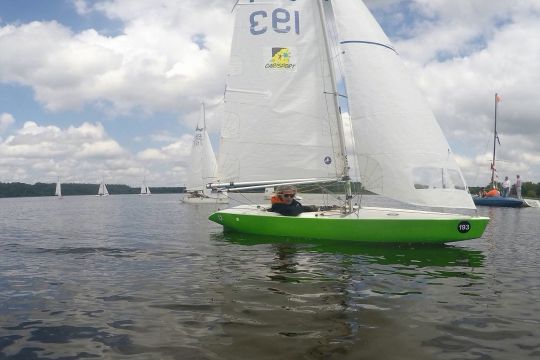
Financially, how did it go?
In the early 2000s, the allocations made by the departments and regions to promote accessibility to sailing were significant: clubs were able to buy adapted boats. At that time, it was mainly MiniJi that were acquired. These French boats were well adapted to people with disabilities, especially for racing and experienced sailors. On the other hand, for initiation or discovery, they were less practical, because it is a boat with which you sail alone..
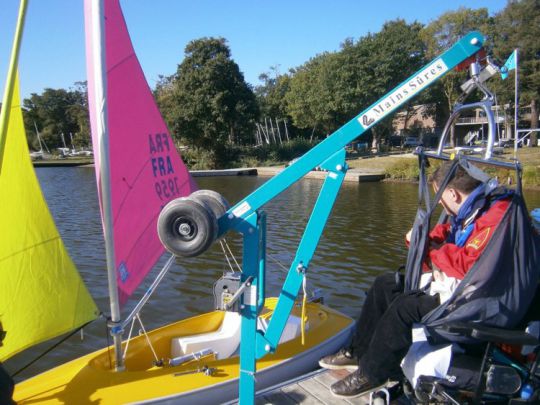
What solution has been found?
The clubs headed for other boats, including the Australian Hansa, for two people. The Model 303 was then used as a typical training boat. Two people with disabilities or only one with an able-bodied person could sail together. Unfortunately, the import of this brand was a problem. Some clubs that had ordered them were never delivered...
A new boat again, then?
That's right! In particular the Neo 495, another French double-handed boat. A little larger, more efficient, with a bulb keel, it allows a wider range of use than MiniJi or Hansa. It is also a little more expensive than its predecessor... Other boats exist, but remain at the prototype stage for the time being.

Where did handicapped sailing develop in France?
In fact, it is very variable. Take Lorient: despite the fact that it is a city very oriented towards sailing, with the Cité de la Voile, the competition centre... Well, before our section created only 2.5 years ago, there was nothing. And today, we still lack the equipment... On the other hand, a village located in the land near a body of water can offer a gallows, an adapted pontoon... If people are struggling locally and they know how to make themselves heard by the political leaders of the communities, then handicapped sailing has a better chance of developing.
What future do you see for handicapped sailing?
There is still a lot of work to be done before we can offer an introduction to sailing to every interested person with a disability, or a regular practice to those who are already fans. Then, in the field of access to regattas and offshore races in habitable boats, a formidable field of innovation and experimentation remains to be explored, in my opinion. For investors as well as technicians and engineers, finding the right financial and technical solutions is a real challenge.
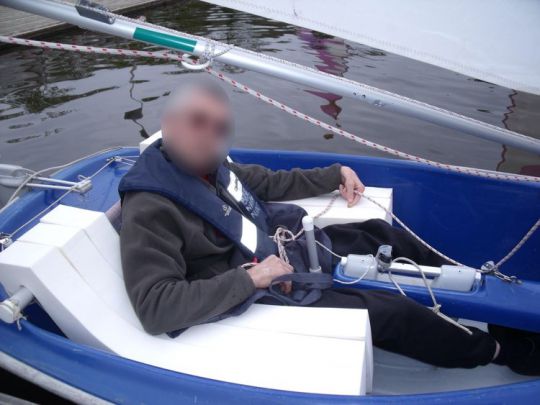
You talk about boats that are not only waterproof and unsinkable, but also "adapted". What types of facilities are involved in practice?
The shape of the cockpit, for example, must allow a person with a physical disability to settle in. For those who do not have the use of their legs, but who have the use of their arms, a steering wheel can be installed. On board the Hansa, a kind of joystick is positioned in the middle of the cockpit, between the two seats: to steer, simply lean it to the right or left. For sailors who cannot use their arms, foot controls are installed. For those whose four limbs are inoperative, a motor brain is integrated on board: it is an electrical device that allows you to steer with a joystick. There are also larger adapted boats: for example, in Fécamp, the Normhandimer association has a 12-metre Scholl 39, which can accommodate about ten people, some in wheelchairs.
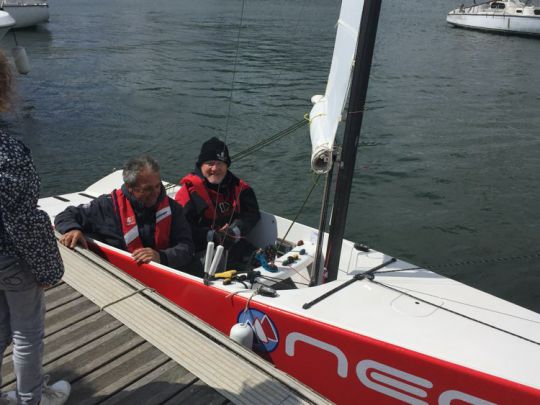
What feedback do you have from the people with disabilities you support?
You know, whether you are valid or disabled, being on the sea, on board a boat that flies silently thanks to the wind, and driving where you want... it's always an indescribable pleasure, and at the origin of a delightful feeling of freedom. I imagine that for people with disabilities, there is an additional dimension: for the able-bodied, sailing is a practice like any other, but for people with disabilities, being able to be autonomous or almost autonomous on a boat, succeeding in controlling it, is something else... you leave your chair on land. And when it comes to sports handicapped sailing, the stakes are probably even higher: there are sailors with disabilities who obtain better rankings than the able-bodied..
